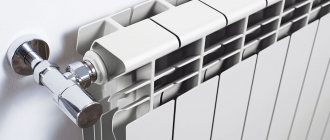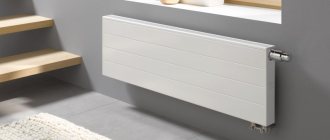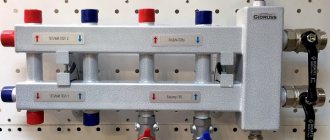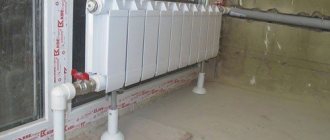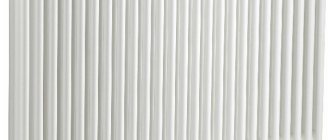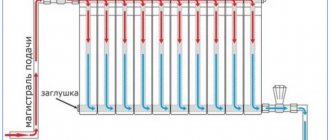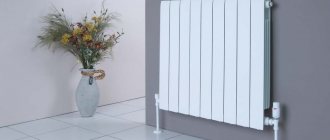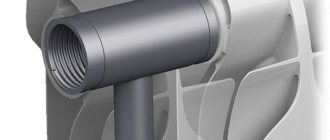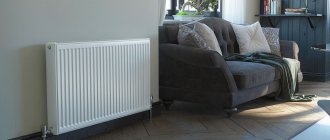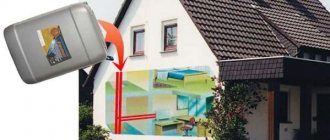Despite their higher cost, vertical heating radiators are gaining popularity. They allow you to organize heating of rooms with a non-standard layout, where it is quite difficult to install horizontal radiators.
This is an excellent solution for rooms with high ceilings of 4 m or more, since vertical structures enhance the convection of warm air to a much greater extent. Sometimes vertical radiators are simply an unusual, attention-grabbing design solution.
What are vertical heating radiators?
In apartments and private houses with a classic layout, it is customary to install batteries under the window sills. This is due to the fact that most radiators have a section height from 380 to 750 mm. To increase productivity (heat transfer), the number of sections is increased, increasing the effective surface.
Agree, it doesn’t look harmonious.
Recently, designers have been using new layout schemes, for example, panoramic glazing with minimal openings between windows. It is difficult to install convectors in such cases, and the appearance of the structure is not suitable for residential premises.
Another thing is the vertical design.
The situation can be corrected by installing high vertical radiators, which have a larger surface area and, therefore, more productivity.
Vertical radiators are usually called radiators whose height of sections significantly exceeds the width of the device.
Photos of classic and design solutions in the interior of the house
Zehnder Charleston 2180.
ZEHNDER 2180.
Purmo Delta 1500x200.
GUARDO PILON S4H.
Color combinations
Stylists advise taking into account the following nuances:
- direction in the interior;
- combination of shades;
- illumination
It is much easier to choose a palette if the style for the kitchen and living room has already been selected. For example, neoclassicism and Provence have their own combinations. In a classic interior, designers combine pastel colors, pale colors, which are slightly diluted with dark shades.
In French country houses you can often see soft blue, pink, and pistachio colors. Art Deco designers make up objects and finishing materials in black and white, sometimes beige and brown or silver and black. The main thing is to choose a shade for the walls. White will become universal, it will expand the space, and later you can paint them with any paint.
However, in the cooking area, white ceases to look fresh. Beige or gray shades would be more practical. This background will highlight the other colors. In a monochrome interior, designers recommend gluing wallpaper in an unusual color or with a photo print.
Waterproof surfaces are easy to clean, so washable wallpaper is recommended. The colors of the furniture echo the details and accessories, be it cushions for the sofa, curtains or other items.
- Cast iron radiators
Radiator flushing
- Gas convectors
Comparison of tall vertical batteries with horizontal ones: advantages and disadvantages
| Properties | Vertical radiators | Horizontal (classic) radiators | |
| Appearance | Designer execution | Designer execution or standard solutions for everyday tasks | |
| Temperature maintenance | Depends on the correctness of the calculations | ||
| Price | High | Average or budget | |
| Safety | High with the right choice of equipment | ||
| Life time | From 5 to 10 years warranty with the right choice of equipment | ||
| Manufacturability | Easy installation | ||
| Balancing | Requires experience with different radiators in the system | Simple | |
| Working and maximum pressure | Operating modes are taken into account when purchasing equipment | ||
The following are important for installers and the operating organization:
- manufacturability (ease) of installation and replacement;
- convenience of balancing the heating system in a private house;
- compliance of technical characteristics with operating conditions - type of coolant and maximum operating pressure.
Based on the totality of the evaluated parameters, it can be understood that vertical batteries have two important advantages over conventional radiators:
- an unusual appearance that adds style to the room and increases the status of the owner in the eyes of guests;
- ease of use for certain types of design.
The main disadvantage for the mass consumer is the high price of the product.
Experts note the difficulty of setting up the system if the composition includes different types of batteries - in this case, it is sometimes difficult to achieve the same flow of coolant through the convectors.
Installation recommendations
The significant height of vertical radiators excludes their traditional installation under window sills. For these products you will need completely different places. This needs to be taken into account before purchasing. Otherwise, certain difficulties may arise. It is also worth thinking about the correct piping.
Where to install
To install vertical models, partitions between windows are often used, but a regular wall or partition will do. The main thing is that it is durable if the unit is steel or cast iron. Such products have a significant mass. If the partition is plasterboard, it is better to use the floor option.
If there is a niche in the room, it can also be used for a radiator. A corner of the room will also work. Modern models are equipped with everything necessary for installation: brackets, overlays, fasteners. It is recommended to install a heated towel rail in bathrooms, which is included in the package of many manufacturers.
The heater must not be covered with furniture to avoid reducing heat transfer. It should be open, especially since modern products have a stylish design and can decorate any interior.
How to connect
The connection diagram largely depends on the technical capabilities of the pipe connection. For example, if in a private house the autonomous heating system has a top connection (a straight pipe runs along the top), then you should look for a radiator with a top connection. With bottom wiring, the connection can be lateral, diagonal or bottom.
A saddle connection, when the forward and return lines approach the bottom of the unit horizontally on both sides, is not recommended, since with this scheme losses of thermal energy will be observed. Practice has shown that in this case, heat transfer is reduced to 25%.
For the same reason, the top connection is not used for bottom wiring of the heating system. A connection is considered to be downstream when the forward and return pipes come out of the floor. Most foreign manufacturers integrate a thermoregulation mechanism into their units. It is configured at the factory. You need to remember this.
In such heating devices, the direction of the working medium is always one-sided. How the coolant should flow through the radiator is indicated in the product’s operating manual. If you connect it the other way around, at best, the unit simply will not heat up, and at worst, the thermoregulation mechanism will fail.
Types depending on material of manufacture
Cast iron
Cast iron model Retro Style LILLE 813/95.
Reliable metal, practically not subject to corrosion. For manufacturing, a casting method is used, which makes surface treatment difficult. Because of this, the appearance of the products suffers.
Thick walls cause a large mass of the structure, which is inconvenient during transportation and installation. In addition, cast iron is not resistant to shock loads and is easily damaged when moved.
The maximum height of cast iron vertical radiators available for purchase can reach 1,000 mm, which is not so much to provide adequate heating in cold regions.
Wall-mounted options are placed only on durable external walls and solid partitions. The working pressure of cast iron radiators is, as a rule, 10 atm, and the pressure testing pressure is up to 15 atm. The devices can be used with any type of coolant heated to a temperature of 120 °C.
Steel
Steel model Purmo Delta Laserline 2180.
The ease of processing and the cost of metal make it possible to produce steel radiators in a low price category.
Steel products are made in the form of cast or tubular sections, as well as panels, between the walls of which coolant circulates.
Product advantages:
- low price;
- light weight, allowing installation on non-permanent walls;
- ease of installation;
- variety of appearance and colors;
- presence on the market of products with anti-corrosion treatment of internal surfaces.
Flaws:
- low operating pressure values - from 6 to 10 atm;
- accelerated corrosion of internal surfaces for inexpensive models, even despite anti-corrosion. coatings;
- welds that reduce strength.
How to choose steel heating radiators Design, selection criteria and best models
The main disadvantage is the impossibility of using it in multi-storey buildings with centralized heating, where the operating pressure can reach 10 atm, and the pressure test pressure can reach 15 atm. This property sometimes does not apply to tubular radiators, the characteristics of which may be suitable for such operating conditions.
Steel radiators are produced in three designs.
The model in the photo is Piano Vertical - TRC.
The first type (sectional) is a radiator in which identical sections are connected. By adding elements, you can form a battery of the required power.
Advice! It is not advisable to combine a large number of sections in a vertical radiator, since a large surface area contributes to increased cooling of the coolant. If there are several radiators in the circuit, then the latter will be filled with cooled coolant and the room will not warm up sufficiently.
The model in the photo is Zehnder Charleston 3180 Completto.
Tubular models are non-separable and in design, as a rule, are a set of individual pipes connected at the top and bottom by manifolds. Due to the lack of ribs, they have lower productivity compared to the sectional type. At the same time, they have an unusual appearance, which is often used in design projects.
Due to the absence of threaded connections, the tubular type is considered the most resistant to destruction during pressure testing and hydraulic shocks.
The inner surface of some models is coated with an anti-corrosion layer, which increases service life.
The model in the photo is Stelrad Vertex 10 300 1600.
Panel radiators can be of various designs.
The most common options are when steel pipes with circulating coolant are welded between two sheets. Modern models can be equipped with a front wall made of glass and mirror, which gives the room an exclusive appearance.
Aluminum
Aluminum OSCAR 1800/12 GLOBAL.
Aluminum radiators are comparable in price to steel ones, but are somewhat inferior to them in technical parameters.
For your information! Pure aluminum is rarely used for manufacturing due to the plasticity of the material. Silicon, copper and other chemical elements are added to the alloy to add strength.
Positive properties:
- low price;
- the minimum amount of coolant required to fill the system;
- light weight;
- fast heating and cooling, which helps to regulate the room temperature accurately and in a short period of time;
- high heat transfer coefficient, allowing to save energy resources in private homes;
- attractive appearance.
Among the disadvantages are:
- coolant leaks at the joints of sections after several years of operation due to thermal expansion of the alloy with temperature fluctuations;
- short service life;
- high activity of aluminum and the formation of gases during chemical reactions with the coolant.
Important! Aluminum radiators cannot be installed in multi-storey buildings with centralized heating due to low mechanical strength.
Bimetal
Bimetal model Royal Thermo PianoForte Tower Bianco Traffico.
So-called bimetallic batteries are one of the best vertical heating radiators for an apartment.
Structurally, the products consist of an inner tube made of stainless material (steel or copper), which is surrounded by an outer shell of aluminum.
This allows you to obtain a battery with technical characteristics suitable for use in any conditions: steel gives strength, and aluminum easily transfers heat and allows you to make the battery visually attractive.
Important! Externally, bimetallic batteries cannot be distinguished from aluminum ones, so when purchasing, be sure to clarify the information and require a product passport with a certificate.
Types of tall batteries
With all the wealth of choice, vertical units are divided into 2 large groups. In this regard, buyers are always faced with the question of which tall heating radiators to buy: water or electric. Here, a lot depends on the layout of the premises and on the family budget.
Water radiators
These models can often be seen in houses and apartments for one simple reason: heating a home with hot water is much cheaper than using electricity. And in terms of design, manufacturers offer a greater variety of models.
The non-demountable panel structure has a continuous flat facade. It could be a metal sheet, glass or mirror. Such models can act as independent interior items. The reflective mirror surface expands the space and adds light.
The tubular unit consists of upper and lower collectors connected by welding pipe sections. Quite often, the parts of the device are bent to give it an original shape. Most often, steel is chosen as the material for manufacturing. To maintain high heat transfer, pipes must be washed periodically on all sides.
Sectional radiators have a flat facade and consist of several parts.
They are characterized by the following features:
- look aesthetically pleasing;
- are aluminum or bimetallic;
- have the highest cost among other types of heating devices;
- collapsible design allows you to assemble the required number of sections in one product;
- give off heat according to the principle of convection;
- require minimal care.
If a private house has an autonomous heating system from a boiler, the type of design of the devices is not of fundamental importance. In any case, the generated thermal energy will be distributed throughout the living space.
Electric batteries
This type of heating units uses electrical energy to generate heat. Some devices are pumped with a working fluid as a coolant: distilled water or oil. Others work on the principle of direct heating, transferring energy from the heating element to the body of the device.
It is not economically feasible to use vertical electrical structures, therefore they are used extremely rarely as the main source of heating of premises. More often they are installed as an additional heating unit and operate in short-term mode, supporting the water heating system.
The equipment is equipped with thermostats integrated into the device, which allows the radiators to turn on automatically as soon as the temperature drops to a predetermined level. This product has its own target audience, albeit a small one.
How to choose vertical heating radiators for an apartment or house
Minimum required power
To accurately calculate the required thermal power of radiators, complex calculations are required that take into account the climate in the region, the building material of the walls and the quality of their insulation. Be sure to take into account the height of the ceilings and the total volume of the room, the number and area of glazing, which side of the world the windows face.
How to accurately calculate the required boiler power Individual calculation, correction factors and online calculator
The simplest method of calculation is often used - it is believed that to heat a room with a ceiling height of 2.7 m, a radiator power of 100 W per 1 m2 is required. Thus, for a room of 20 m2, the total thermal power of the batteries is 2,000 W.
The passport of any product indicates the power of one section; it is necessary to purchase a radiator or several products in order to fulfill the calculation conditions. For example, if the documentation indicates that the power of one long section is 400 W, then for a room of 20 m2, purchase a radiator of at least 5 sections or 2 products of 3 sections each.
Allowable pressure
In private houses with autonomous heating, the heating boiler is usually protected from increased pressure, which is released through special valves. If necessary, establish a separate security group. Therefore, the pressure in the system does not exceed 3–4 atm for three-story buildings.
Taking this indicator into account, purchase batteries that can withstand such values. Almost any product is suitable for a private home.
In high-rise buildings, the operating pressure reaches 12 atm, and water hammer can be up to 16 atm - this is taken into account when purchasing. If the convector is destroyed, the neighbors below are guaranteed to be filled, and the steam-water mixture with a temperature of up to 110 °C can lead to serious burns.
Connection type
There are three types of connection for vertical radiators:
- lower;
- lateral;
- diagonal.
The type of connection affects the ease of installation and maintenance, as well as the appearance of the assembled system.
To power batteries with bottom connections, pipes are embedded in the floor or laid under the floor covering, sometimes placed in the wall. The eyeliner is almost invisible. To configure the system, it is possible to install a flow direction adapter, which simplifies adjustment. But this option is not workable with a gravity heating system and requires a circulation pump. In other words, simply replacing the radiator without reworking the entire outdated system will not work.
The heat transfer of batteries with bottom connection is reduced by 10-15% compared to side or diagonal connection options.
The connection with side outlets is suitable for all heating systems. The option is the simplest to implement and allows you to install shut-off valves or control equipment on each battery. The battery is evenly filled with coolant and releases heat into the space. For radiators with several sections, it is recommended to connect using a flow extender. This allows the hot coolant to be distributed evenly between all sections, which improves heat transfer.
Diagonal connection is suitable for replacing wall radiators in gravity systems. Water flows by gravity into the battery through the upper fitting and, flowing down the sections, heats the battery.
Furniture items
A few examples of furnishing a kitchen combined with a living room:
- 1. Sofa. It becomes an object that zones space. The sofa is placed with its back facing the place where food is prepared. In small rooms (less than 20 sq m) a corner is placed, which is placed against a wall installed perpendicular or parallel to the kitchen.
- 2. Set. According to designers, minimalist models without elaborate details look modern. The service, vases or glasses are placed on an open shelf. You can buy a fashionable display case for them. Furniture is placed near the wall. If the space is large (20 sq. m, 25 sq. m or 30 sq. m), then in the central part you can install an island, which also has sections for kitchen appliances.
- 3. Furniture set. The style should be combined with the design of both rooms. In small rooms, a compact table and chairs made of transparent material or painted in light colors look good. You can add a table with a round top to your living room interior. In spacious rooms, the kit is installed near the wall or in the central part. An elongated rectangular dining table would look good here.
The best known manufacturers and models: characteristics and prices
Loten Gray V 1750 mm
The development and production is carried out by the Loten company with a central office in Moscow and representative offices in large regional centers in Russia and Belarus.
Models in the Loten Gray V line are tubular radiators made of rectangular steel pipe with a cross-section of 60x30 mm and a thickness of 2.5 mm.
In the standard version, inexpensive radiators are available with right or left side, as well as bottom connections spaced apart from each side. By individual order, it is possible to connect sections in such a way as to organize any type of side or bottom connection.
The height of the section in the model is indicated in the name and ranges from 750 to 2000 mm (specific model 1750).
Painting in RAL colors adds 10% of the cost. Manufacturer's warranty for installation by certified services for at least 5 years.
Low and long heating radiators: detailed analysis More comfortable heating, stylish design and small coolant volume
KZTO Harmony 1-1750
The Russian company is located in the city of Kimry, Tver Region and produces tubular-type heating devices.
Section height 1750 mm. The maximum pressure is 15 atm and the operating temperature is up to 120 °C, allowing the use of radiators in multi-storey buildings with centralized heating.
Important! Radiators equipped with temperature control equipment are used in systems with pressures up to 10 atm.
Arbonia 2180
The international company's factories are located in the Czech Republic, Switzerland and Germany. Because of this, the price of batteries is in a high price segment.
Structurally, each section consists of 2 pipes, then the product is assembled in the desired design. Section height 1,800 mm.
Royal Thermo PianoForte Tower
The production of the Russian company is located in the Vladimir region.
The model is a bimetallic radiator assembled from 18 sections located horizontally.
Seller's warranty 5 years. Radiators are painted in RAL colors.
Mandarin 1200 Alum
The products are manufactured by a Yekaterinburg company. The product is a radiator made of aluminum square pipes 30x30 mm. Installation in horizontal and vertical planes is allowed.
The radiator is painted with polymer dyes, the declared service life is 50 years. The maximum coolant temperature is 130 oC.
Purmo Vertical
Currently, Purmo Vertical radiators are produced at a plant in Poland.
Delivery is carried out by Russian representative offices in Moscow and St. Petersburg.
Purmo Vertical is a stamped panel radiator with a profiled front panel with a height of 1,500 to 2,300 mm and a width of 300 to 750 mm.
The maximum permitted pressure in the system is 6 bar, which limits the scope of use of radiators to private houses.
What to do if the bottom or top of the battery is cold
In the case of a cold top, the reason most often lies in the air accumulated in this part of the heating device. One has only to bleed it using a special valve (called the “Mayevsky valve”), and the functionality of the connecting device is restored. Some foreign models have an automatic valve that bleeds air as it accumulates.
With a cold bottom the situation is more complicated.
It can cool down for a number of reasons:
- system blockage;
- insufficient coolant pressure;
- low temperature of the working environment;
- incorrect radiator connection diagram;
- The valve (ball valve) is installed incorrectly.
Once the specific cause is identified, the problem must be corrected. The blockage is cleared by disassembling the system and then flushing it. The low temperature is increased using a thermostat for a gas or electric boiler, which has several modes for heating the coolant. The pressure of the working medium is increased by inserting a circulation booster pump.
An incorrectly installed ball valve or valve is dismantled and turned 180 degrees. On the body of the shut-off and control valves there is an arrow in the direction of movement of the working medium. If the bottom is cold due to an incorrect connection diagram, it is changed by re-cutting. For example, the saddle version is replaced with a diagonal one. Read about wood heating stoves for your home on our website.
Prices: summary table
| Model | Working pressure, atm | Maximum pressure, atm | Heat dissipation, W* | Cost of 1 section, rub. | Price, per 1 kW of power, thousand rubles. |
| Loten Gray V 1750 | 16 | 24 | 208 | 3400-4000 | 19 |
| KZTO Harmony 1-1750 | 15 | 20 | 512 | 1200 – 2100 (factory holiday) | 2,3–4 |
| Arbonia 2180 | 10 | 15 | 209 | 3000 – 4000 | 15–20 |
| Royal Thermo PianoForte Tower | 15 | 45 | 200 | 2000 | 10 |
| Mandarin 1200 Alum | 15 | 16 | 210 | 3500 – 4000 | 16–19 |
| Purmo Vertical | 6 | 10 | Depending on size | According to price |
*Note. Measurements are carried out at a temperature difference between the coolant and air in the room equal to 70°C
When choosing vertical radiators, you should pay close attention to the technical characteristics of the products declared by the manufacturer and confirmed by certificates. In this case, it will be possible to avoid accidents in the heating system and additional costs for equipment repairs.
Heating radiators
Installing the battery into the system
When choosing one or another type of low radiator, you need to decide on its parameters based on the size of the window and the required heat transfer.
The length of the heat exchanger should be equal to the width of the opening or exceed it by 200-300 mm. Having the skill to use the necessary tools, it is not difficult to connect the radiator to the system with your own hands.
The following instructions will help with this:
- determine the type of system - one- or two-pipe;
- determine the most optimal connection diagram - diagonal, one-sided or bottom;
Unobtrusive interior element
- Next, we install taps on the supply and discharge pipes. allowing to shut off the coolant supply in an emergency;
- We screw the Mayevsky tap (top) and the plug (bottom) into the remaining holes.
- preliminary assembly can be done dry, the final connection is made using linen winding and plumbing paste;
- Batteries made of various metals can be connected to heating systems made of metal, metal-plastic and polypropylene pipes.
Montage in pictures
Features of installing high radiators
Connecting batteries of any format has a lot in common, regardless of the model type. Connection to the heating riser is made in different ways:
- diagonal (most effective);
- lateral (standard);
- bottom connection.
Among steel elements, tubular systems are considered the safest.
Helpful advice! Before purchasing, it is important to make sure what type of connection this model will correspond to.
Vertical panels are usually connected from below, but, if possible, it is better to weld the pipes to make a diagonal coolant supply. It will ensure the most efficient filling of the battery with warm water before returning to the return line.
Vertical batteries must be installed on reinforced walls, otherwise, due to the heavy weight, the structure will simply fall, tearing out part of the wall.
With a lower connection, all recommendations remain the same as for horizontal cast iron accordions. But vertical models have one feature - the water pressure in the system should be enough to fully fill the heating equipment.
Common types of low batteries
Since radiators are designed very simply, the differences between them are based on the geometry of the case, what material it is made of, and what type and size the radiator fins are.
The minimum dimensions of a low radiator are usually 0.2 meters high, 0.5 meters long and 0.1 meters deep. Maximum dimensions can be 0.5 meters high, 6 meters long and 0.23 meters deep.
The design of low batteries is determined primarily by materials, such as:
The batteries are sections obtained by casting. For heat exchange, each section contains a number of ribs determined by the design.
The properties of cast iron determine both the disadvantages and advantages of such a radiator. Cast iron is brittle and like an eggshell, which, due to its convexity, is strong on the outside, but easily destroyed from the inside. Therefore, the water pressure inside such a radiator should be less than 9-11 atmospheres. And since the surface of cast iron after casting turns out to be rough and uneven, debris settles on it inside the radiator over time and creates a layer that weakens the transfer of heat from the water to the cast iron of the radiator. But despite the mentioned disadvantages, a cast iron radiator retains heat well and is not subject to destruction from prolonged contact with water.
The casting method does not allow steel to obtain the ribbed shape required for the radiator. For this reason, low steel batteries are made from individual plates and are often combined with pipes. A low battery based on a pipe framed by plates that serve to increase convection has heat losses due to gaps that occur where the plates are attached to the pipe.
If the radiator is made of steel plates that form cavities for filling them with hot water, the heat transfer is much greater than that of a pipe-based radiator, but the resistance to water hammer is reduced due to the presence of seams connecting the plates, which is one of the disadvantages of such radiators .
Another disadvantage of steel radiators is rust, which appears inside upon contact with air oxygen in a humid environment. In addition to the mentioned disadvantages, steel radiators are very expensive due to labor-intensive manufacturing and the need to use corrosion-resistant steel. In terms of heat transfer properties, they are close to cast iron radiators.
Aluminum batteries can be either cast, extruded, or made from wafers. Their main advantage is their weight, which is significantly less than that of cast iron and steel.
In terms of their ability to withstand water pressure, aluminum radiators are almost one and a half times better than cast iron ones. But the convection properties of aluminum are worse than those of cast iron and steel.
In addition, aluminum is less durable than cast iron and steel, so water hammer can quickly lead to water leaks through cracks that appear in the body. For this reason, the service life of such radiators is shorter than that of cast iron and steel.
This radiator is made of several parts. the material of each of them is selected to best suit the task being performed. In such a battery, water passes through a pipe made of copper alloy or other material. The pipe is capable of withstanding water pressure of several tens of atmospheres and is not subject to destruction from prolonged contact with water. Therefore, its service life will be comparable to a cast iron battery.
To increase the surface area of contact with air, plates made of aluminum or an alloy of non-ferrous metals are placed on the pipe. Such a radiator may have small dimensions, but due to heat loss at the point where the plates are attached to the pipe, its efficiency will be less than that of aluminum batteries.
The complexity of manufacturing and the use of non-ferrous metals makes such a battery more expensive than an aluminum one.
Pros and cons of vertical format radiators with bottom connections
The excellent design of a vertical panel or tubular heating radiator is the main advantage of this format. They fit perfectly into most modern design concepts. Some models can hardly be called a “battery” until you touch a warm surface with your hand.
A distinctive feature of such systems is their orientation in height with a reduced width.
Vertical units are installed in addition to horizontal equipment or instead of traditional batteries. It is easier to find a place for them when there is no window sill niche or it is not spacious enough to install a large heating unit. They are characterized by:
- high thermal output;
- variety in color and design;
- ease of installation (all parts for installation are included);
- space saving (a little space in width on any free wall).
Among the “disadvantages” are:
- more time is needed for “acceleration” during primary heating;
- uneven heating at high altitude and insufficient pressure in the system;
- relatively high price;
- tendency to clog in the lower part of the radiator, where the coolant is supplied.
The main sign of contamination is cold radiators and warm pipes that are connected to them. Since all the dirt accumulates at the bottom, they have to be disconnected periodically and purged or washed. An exhaust valve must be installed at the top point to remove excess air.
Thanks to this arrangement, it is possible to fit such batteries even into a small space, maintaining the required amount of thermal energy.
